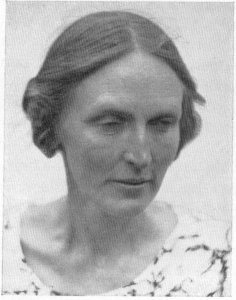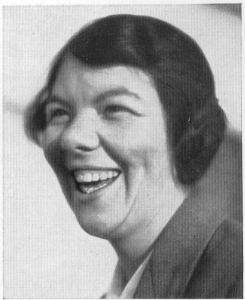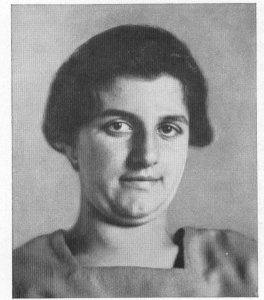Ludwig F. Clauss: Racial Style, Racial Character (Part II)
Continuing from Part I with a translation of parts of the third edition (1943) of Rasse und Seele, by Ludwig F. Clauss.
“To each according to his kind, to each according to his style”
The movement of the body is the expression of the movement of the soul. This can best be seen in the interplay of facial muscles and in the gestures of the arms and hands with which the speaker accompanies his speech. Why is he moving his hands in such a way and why not differently? Because the special way of his spiritual alertness will also determine the way his hands move. The style of spiritual movement determines the style of the bodily movement.
Here is a little example from day to day life that illuminates this matter. Who is more gifted to drive a motor vehicle, the Nordic man or the Mediterranean man? This question is also meaningless. Neither “the” Nordic man is endowed with this or that, nor is “the” Mediterranean man. There are many individuals of both races who are gifted to drive a car. If that’s the case, then the Nordics do that in a Nordic way and it is precisely by this that they are recognizable as Nordics.
The same goes for the Mediterranean who does it in the Mediterranean way. And it is precisely by this that he can be recognized. And this is how these two styles differ. The Mediterranean driver is the master of the moment: he is always there, always in perfect instantaneity. He drives with an abrupt change at lightning speed and at a sharp curve he yields and slams on the brakes with instantaneous effect — the more dangerous the driving, the more impressive is his game. At this stage the Nordic man is not comparable—not because he is a bad driver, but because the laws of his mental and physical movement compel him to a different driving style.
The Nordic man does not live in the world as it is; he lives always in the world as it will be. He is not the master of the instant, but rather the master of the distance. He is not cutting suddenly into the curve; he bends the curve. For him turning is “nice” if it can be predicted and then, if possible, played down. The Mediterranean driver loves surprise: only in it he can prove to be the master of the moment. The Nordic driver anticipates always ahead of the coming event, even a possible coming event. In this way he provides for himself some preplanned traffic regulations for all possible cases, which would likely irritate the Mediterranean driver, perhaps more so than it would make the driving easier for him. For the driver of the Mediterranean type there is no relief if the thrill of surprise is missing.
The third fallacy of L’Osservatore Romano is the allegation that the German people are equated with the Nordic race, whereas the Italian people are equated with the Mediterranean race. Although this is not explicitly mentioned it is tacitly suggested. The German people are composed of several races, where, of course, the Nordic race predominates. But there is also different blood among the German people, as for example, the Mediterranean blood. Likewise, the Italian people are also a mixture of several races, of which — at least in the southern part of the peninsula — the Mediterranean race predominates. But there is also different blood among the Italian people, such as Nordic blood. It is by no means true that these two peoples are separated by sharp racial boundaries; they have a good deal more in common in their blood.
This blood relationship stretches into the earliest Roman times and has been renewed many times ever since. And in both cultures, in the Germanic, as well as in the Roman, the play and counter-play of the Nordic and the Mediterranean operate; except that each culture shows different results. The Roman is older, whereas the Germanic is younger. Which one is worth more, the older or the younger? This question also seems to be wrongly put.
The attempt, to sow distrust between friendly nations, by suspecting German racial policies, can no longer be valid. Every step in the field of international politics and colonial politics confirms the findings of the psychology of race and proves it with practical usefulness when dealing with other types of people. Thegoal (of race psychology) is not to separate peoples, but to connect peoples insofar as it establishes between one type and the other a scientifically based mutual understanding. [Emphasis in text.]
The Gestalt: Psycho-Racial Anthropology
Clauss introduced new concepts, often using words and compound nouns that up until then had been nonexistent in the study of race. When translated today, these words may lend themselves to dangerous conceptual manipulations, which in turn, liberal masters of discourse will quickly label as “racist.”
This is generally the case with the German language, a stupendously rich language known for its numerous inflections. Very often Clauss uses the term ‘Gestalt’ when providing racial typologies, a word which in English can be translated as ‘shape’ or ‘form’. However, in the German language and depending on the subject matter, ‘Gestalt’, when used from the nationalist and politically conservative point of view, may refer to aesthetic and cultural perfection in the description of high forms of Western civilization. The German term ‘Gestalt’ was very popular in Germany in the first half of the 20th century, not just in the realm of race but also in other fields, such as literature and philosophy. Clauss’s contemporaries, the German philosopher of history, Oswald Spengler, or the novelist and essayist Ernst Jünger, two scions of the pre-WWII “revolutionary-conservative intellectual revolution,” often used the term ‘Gestalt’ as a normative reference to aesthetic and political magnificence and as a radical opposite to the dreaded liberal–communist formless system permeated by the process of uglification and decadence.
Clauss’s focus on racial style and form, which he calls ‘Gestalt’, must not be confused with the school of psychology, known as “Gestalt psychology” that developed among some liberal German psychologists in the mid- 20’s—a school, that downplayed the racial factor.
For Clauss and for many racialist scholars of his time, every racial type and every racial subtype represents objective reality differently. Hence, there is no absolute truth but only a specific apprehension of the truth based on the individual’s own psycho-racial make-up.
Because everything that happens here — the way somebody looks at us, the way he behaves, or the way how he acts, that is to say, all living things altogether — have their racial traits. A treasure trove of such fruitful examples is provided by history. One, of these motives in Germanic life, repeatedly mentioned by Tacitus, is “loyalty”, which is in contrast to the no less effective violation of Germanic loyalty: treason. ( Rasse und Seele, pp. 38–39)
Race is by no means only a physical expression relegated to a given spot on Earth, such as for instance the assumption that only the geographic areas of Scandinavia must house Nordic peoples. Clauss rejects the idea that racial anthropology must always match racial psychology. There are many individuals who can have Nordic physical traits (phenotype) but whose behavior is un- Nordic:
Some people understand this word as if the race (Nordic) can only be found in northern Germany. Both of it is not the meaning of the description “the Nordic race.” The Nordic race is also a creator and a carrier of the German spirit in southern parts of the German national territory, whereas in other parts of northern Germany – similar to the Scandinavian lands (except for Nordic blood), live also non-Nordic races. A definition, which could be useful in psychology, will acquire the denomination “Nordic” only when we manage to demonstrate the connection between the Nordic landscape and the lifestyle of that race. A psychologist should denominate races only according to the pattern which the process of his research brings under his eyes. To investigate into the psychology of races means first and foremost to discern the meaning of its bodily form (Gestalt). This meaning, however, can only be understood from its psychological form (Gestalt). (Rasse und Charakter, 1942, p. 43; emphasis in text).
This proves once again that the idea of national identity and nationality at large cannot be automatically equated with the extent to which one embodies a racial archetype. The following four photos illustrate three different German types and a Jewish type:

1. German woman from Schleswig. Predominately Nordic. Eye expression shows inborn sense of the tragic.

2. German woman from Westphalia. The “acquired” smile is typically “Germanic,” yet facial features and the shape of her nose show a sharp “Alpine” (“ostisch”) streak.

3. German born Jewish woman. Mixture of Sephardic and Ashkenazi facial traits. Her smile shows “acquired” ( mimicked ) restraint.

4. A very tall German woman from the German speaking region of South Tyrol (northern Italy) (Mediterranean and Alpine streak). The lips alignment and the eyebrows configuration are common for the Dinaric race.
Clauss’s books have therefore a twofold purpose. He demolishes the liberal propagandistic lie that racial awareness means White man’s exclusion of non-Whites, carried through by an alleged blond German beast. Instead, his books teach us that it is precisely when admitting our racial and sub-racial differences, both in style and in character, that interracial hatred can be avoided. Moreover, his works are important insofar as they can be a good lesson for many troubled White nationalists who assume that their well-proportioned body must give them a certificate for bizarre, illicit, or criminal behavior. Who among us have not encountered self-congratulatory White conmen or White lowlifes whose behavior does more harm to the research on race than the palaver of all leftists and antiracists combined? Similar to his colleague Julius Evola, Clauss is aware that some White man may have a perfect race of the body, but whose race of the spirit may be mongrelized to monstrous proportion.
’Artrecht’ (“Being of his own kind”; of his in- group) is not a synonym for being “racially pure” in the original sense of the word. Here we can see the difference between the “raciality” (‘Rassigkeit’) of man and the “raciality” of animal. If somebody is racially pure, he is not automatically a man of his kind (‘artrecht’). To be Nordic, for example, does not have to mean to be a good man or a noble man. Not every Nordic man embodies Nordic values. A man of the Nordic style can also be a crook or a criminal. A Nordic miscreant differs from a Mediterranean, Alpine, or a Middle Eastern miscreant as clearly as a righteous Nordic man differs in this sense from righteous people of these races. Both of them, the righteous man and his negative mirror-image, the miscreant, are bound by the same ethical laws respectively. With one exception: the one abides by it, the other breaks it. Pure heroes and pure crooks are rare; among all of us simmers a temptation to commit, at least once, an outrage against things that we consider right. Not that the race changes in us when we follow this temptation; only our racial system of value is disturbed. Race is race; in good and in bad. And the law remains the law even when it is infringed. (Rasse und Charakter, p. 78).
Clauss’s books are important because they delve into the hidden corners of human behavior as determined by race. His field of research may be labeled “psycho-racial anthropology,” a field which has been rejected for over a half a century by Freudian-Marxian scholars. As long as the mystique of egalitarianism runs full steam in Western society — be it under the guise of Christian “love thy neighbor,” or under the label of the more secular liberal avatars like the “multicultural consensual society” — any serious effort to combat the danger of the multiracial experiment will be futile. Only when the current dominant ideas are successfully intellectually challenged, will the whole fraud of multicultural promiscuity fall apart overnight.
Dr. Tom Sunic (websites here and here) is author, translator, former US professor in political science and a member of the Board of Directors of the American Third Position. He is the author of Homo americanus: Child of the Postmodern Age, prefaced by Kevin MacDonald (2007). The third edition of his book Against Democracy and Equality; the European New Right, prefaced by Alainde Benoist, has just been released.






Comments are closed.